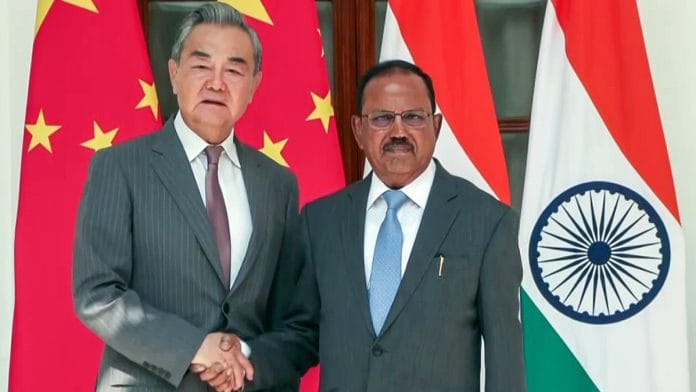New Delhi: Following delegation-level talks Tuesday between National Security Adviser Ajit Doval and visiting Chinese Foreign Minister Wang Yi, both sides agreed on key steps to address border tensions.
While the Special Representatives decided to set up a new expert group and a working group under the Working Mechanism for Consultation and Coordination (WMCC) for boundary delimitation and management, the most striking outcome was a return to the 2005 Agreement on Political Parameters and Guiding Principles for Settlement of the India-China Boundary Question.
Doval and Wang Yi agreed on five steps to push forward ties.
The first is the “need to take a political perspective of the overall bilateral relationship” while “seeking a fair, reasonable and mutually acceptable framework” for settling boundary disputes in line with the 2005 Agreement on Political Parameters and Guiding Principles for Settlement of the India-China Boundary Question, the MEA said in a late night statement Tuesday.
This revival is significant because Beijing had begun undermining the agreement almost immediately after signing it.
China sees in the 2005 agreement an opportunity to delink border disputes from overall bilateral ties, something New Delhi has resisted since the 2020 Ladakh standoff.
Incidentally, following the last Special Representative-level talks between the two sides last year, China had mentioned the 2005 agreement while the Indian official statement kept it out.
The agreement also had a clause which was in India’s interest—“In reaching a boundary settlement, the two sides shall safeguard due interests of their settled populations in the border areas”.
This, the sources said, takes care of India’s assertion that Tawang is an Indian territory since that is a populated area.
The 2005 agreement that China mentions was signed by then Special Representatives, NSA M.K. Narayanan and Chinese vice foreign minister Dai Bingguo, after such a mechanism was set up in 2003.
What 2005 agreement says
The 2005 agreement said the two sides had laid down the ground rules for bilateral ties and border issues.
It said the two sides should, in accordance with the Five Principles of Peaceful Coexistence, seek a fair, reasonable and mutually acceptable solution to the boundary question through consultations on an equal footing, proceeding from the political perspective of overall bilateral relations.
“Both sides should, in the spirit of mutual respect and mutual understanding, make meaningful and mutually acceptable adjustments to their respective positions on the boundary question, so as to arrive at a package settlement to the boundary question. The boundary settlement must be final, covering all sectors of the India-China boundary,” it had said.
The main point of contention between the two sides has been India’s claim over Aksai Chin and China’s claims over Arunachal Pradesh, especially Tawang.
The agreement also said that the two sides will give due consideration to each other’s strategic and reasonable interests, and the principle of mutual and equal security.
The agreement had said that the two sides will take into account, among other things, historical evidence, national sentiments, practical difficulties and reasonable concerns and sensitivities of both sides, and the actual state of border areas.
“The boundary should be along well-defined and easily identifiable natural geographical features to be mutually agreed upon between the two sides,” it had said.
(Edited by Ajeet Tiwari)






